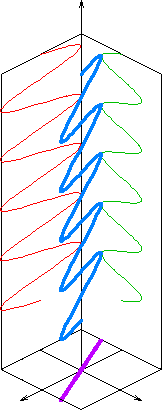
Back استقطاب خطي Arabic Γραμμική Πόλωση Greek Polarización lineal Spanish קיטוב ליניארי HE 直線偏光 Japanese Lineair gepolariseerd licht Dutch Polaryzacja fali#Polaryzacja liniowa Polish Линейная поляризация Russian Linearna polarizacija Slovenian โพลาไรเซชันแบบเส้นตรง Thai
This article includes a list of general references, but it lacks sufficient corresponding inline citations. (May 2020) |

In electrodynamics, linear polarization or plane polarization of electromagnetic radiation is a confinement of the electric field vector or magnetic field vector to a given plane along the direction of propagation. The term linear polarization (French: polarisation rectiligne) was coined by Augustin-Jean Fresnel in 1822.[1] See polarization and plane of polarization for more information.
The orientation of a linearly polarized electromagnetic wave is defined by the direction of the electric field vector.[2] For example, if the electric field vector is vertical (alternately up and down as the wave travels) the radiation is said to be vertically polarized.
- ^ A. Fresnel, "Mémoire sur la double réfraction que les rayons lumineux éprouvent en traversant les aiguilles de cristal de roche suivant les directions parallèles à l'axe", read 9 December 1822; printed in H. de Senarmont, E. Verdet, and L. Fresnel (eds.), Oeuvres complètes d'Augustin Fresnel, vol. 1 (1866), pp. 731–51; translated as "Memoir on the double refraction that light rays undergo in traversing the needles of quartz in the directions parallel to the axis", Zenodo: 4745976, 2021 (open access); §9.
- ^ Shapira, Joseph; Shmuel Y. Miller (2007). CDMA radio with repeaters. Springer. p. 73. ISBN 978-0-387-26329-8.
© MMXXIII Rich X Search. We shall prevail. All rights reserved. Rich X Search